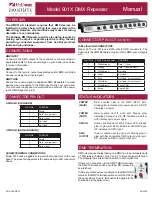
5 - 1
SECTION 5
CIRCUIT DESCRIPTION
5-1 TRANSMITTER CIRCUITS
TX PLL CIRCUIT
TX PLL IC (IC3) outputs resulting signal of phase-
comparison of REF signal (15.3 MHz) and feedback OSC
signal from TX VCO. The phase-difference signal is passed
through the active loop fi lter (Q4, 10, 13)and applied to the
TX VCO. The voltage of TX LV is adjusted to appropriate
one. The OSC signal of TX VCO is FM-modulated by applied
modulation signals.
TX VCO CIRCUITS
There are 2 VCOs; VCO for band LOW (Q23, D10, 14, L19)
and band HIGH (Q22, D9, 13, L18), and these VCO (=OSC
freq.) are switched by the VCO SW (Q27, 28). The OSC
frequencies of these VCO are adjusted (=Locked) by the TX
LV signal (Lock Voltage). The modulation signals applied to
the Variable Capacitor (VD; D17 or D18) vary the capacitor
reactance of it for FM modulation. The output signals of
these VCOs are applied to the power AMP circuits via
buffers (Q24, 35).
A portion of these output signals are passed through the
doubler (Q33) to extract 2nd harmonics, then applied to the
PLL IC (IC3) via the LPF.
YGR/PA CIRCUITS
The output signals from TX VCOs are amplifi ed by pre-AMPs
(Q37, 38), the amplified the PA module (IC22) to obtain
required TX power. The power-amplified TX signals are
passed through the ANT SW (D44) and LPF (for harmonics
removal) then applied to the TX ANT.
APC CIRCUIT
D45, D48 and D49 detect the TX power and the detected
voltage are applied to the IC23 of APC circuit. Comparing
the detected voltage (in proportion to TX power) and power
setting voltage (as a reference voltage), IC23 adjusts the
bias (pin 2: VGG) of PA module to control the TX power.
MODULATION CIRCUITS
The audio signals from the Microphone (MIC signals) are
applied to the MIC AMP (IC25). The amplifi ed MIC signals
are passed through the SW IC (IC35) which signal selects
the source of MIC signals from J5 (from MIC) and from
D-SUB connector (DEXM).
The MIC signals from the SW IC are amplifi ed by an AMP
(IC1) then applied to the LINEAR CODEC IC (IC8) where
the MIC signals are converted in to the digital signals. The
converted digital signals are processed (pre-emphasis,
limit, etc.) by the DSP (IC12), then recovered to the analog
audio signals. The AF signals are amplifi ed by IC1 and level-
adjusted by Ele.VR (IC2), then applied to the TX VCO and
TCXO (X1) as the modulation signals.
SIGNALING (ENCODE)
The Continious Tone (CTCSS/DTCS), Single Tone (5-Tone/
DTMF/CW_ID) signals are encoded in the DSP (IC12), and
mixed with MIC signals, level-adjusted by Ele. VR (IC2), then
applied to the TX VCO and TCXO (X1) for modulation.
5-2 RECEIVER CIRCUITS
RX PLL CIRCUIT
The RX PLL IC (IC4) outputs resulting signal of phase-
comparison of REF signal from the TCXO (X2: 15.3 MHz)
and feedback OSC signal from RX VCO. The phase-
difference signal is passed through the active loop fi lter (Q6,
11, 14) and applied to the RX VCO. The voltage of RX LV (lock
voltage) is adjusted to appropriate one by “RX LVA” signal.
A portion of reference frequency signal from the TCXO (X2:
15.3 MHz) is passed through the tripler (Q2) to extract 3rd
harmonics, then applied to theIF IC (IC5).
RX VCO
There are 2 VCOs; VCO for band LOW (Q21, D8, 16, L21)
and band HIGH (Q20, D7, 15, L20), and these VCO (=OSC
freq.) are switched by the VCO SW (Q26, 30). The OSC
frequencies of these VCO are adjusted (=Locked) by the RX
LV signal (Lock Voltage). The output signals of these VCOs
are applied to the 1st mixer (L27, 32, D62) via buffers (Q25,
34) and LO AMP (Q65).
A portion of these output signals are passed through the
buffer (Q25) doubler (Q32) to extract 2nd harmonics, then
applied to the PLL IC (IC4) via the LPF.
RF BPF CIRCUITS
RX signals from the RX ANT connector (J11) are passed
through the 1st stage of BPF (D28, 29, 31, 32, L44, 47)
then amplified by the RF AMP (Q36). The amplified RX
signals are passed through the 2nd stage of BPF to remove
unwanted signals for good image response then applied to
the 1st mixer (L27, 32, D62).
Being mixed with 1st LO from the RX VCO, the RX signals
are converted into the 46.35 MHz 1st IF signal. The 1st and
2nd stage of the BPF are tune to the pass band frequency
by applying the tracking voltage “T1” and “T2” from the DAC
(IC17). The gain of low noise RF AMP (Q36) is controlled
by the AGC circuit (Q39, D27) according to the RX signal
strength.












































